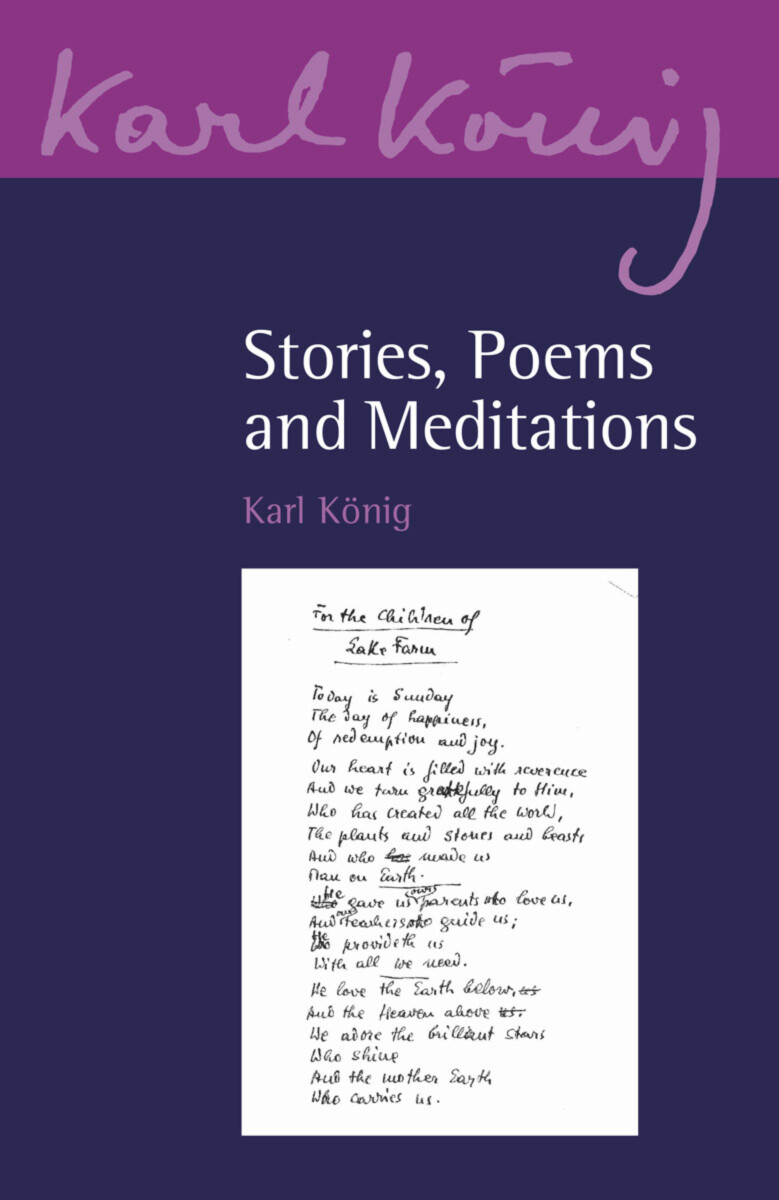- Publisher
Floris Books - Published
21st August 2020 - ISBN 9781782506461
- Language English
- Pages 272 pp.
- Size 5.5" x 8.5"
Alongside his work with the Camphill movement, Karl König was a prolific writer of stories, poems and meditative verses. This book contains:
- A selection of his creative work
- Verses for specific occasions
- Twenty-four poems
- Four stories for children
- Ten other short stories
An extensive introductory essay explores the cultural environments in which König was writing—including Vienna in the early twentieth century, and the challenging times leading up to World War II—and discusses the creative development of his literary work.
C O N T E N T S:
Introduction: "I Want the Meaning of Life"
The Lyrical Work of Karl König
(Alfons Limbrunner)
Editor's Note (Richard Steel)
Meditative Verses
Christmas 1944
Guardians of the Services
For the Goetheanum Windows
For the Children of Lake Farm
For the Friends in America
Poems
For Alfred Bergel
Untitled [1920]
Untitled [1921]
Whitsun
To You, Brother Proletarian!
For Albert Steffen's Pilgrimage to the Tree of Life
Calling Up
Untitled [for Tilla 1938]
For You
For Me
For Turner, the Great Painter
To Germany
Untitled [ca. 1940]
For the Camphill Community
Prater
Pound and Dollar
Verse for the Human Being
Easter Morning
St John'’s Day
Whit Sunday
Eye and Ear
Calendar Verse [1961]
Calendar Verse [1962]
The Tourmaline Secret
One Last Poem? (Richard Steel)
Karl Konig's Last Poem
Stories for Children
Two Addresses for Children
Michaelmas
Advent
Two Parables Arranged for Eurythmy
The Treasure in the Field
The Pearl in the Shell
Short Stories
The Bohemian-Moravian Brotherhood
The Monk's Dream
The Idle Tongue
Brother and Sister
Athena Parthenos
The Three Days
Christmas Past, Present and Future
A Highland Story
One Morning 1352 bc
Also a Christmas Story
Karl Konig'’s Christmas Story (a postscript by Richard Steel)
Appendix
Notes
Bibliography
Index
Karl König
Dr. Karl König (1902–1966) born on September 25th 1902 in Vienna, Austria, the only son of a Jewish family who owned a shoe shop. He studied zoology, biology, and medicine at the University of Vienna, graduating in 1927. During his studies on embryology, König encountered the works of Rudolf Steiner through Goethe's scientific writings. He immediately identified with Steiner and was soon acquainted with a number of his followers, including Ita Wegman.
Upon graduation, König was offered several high-profile positions in Vienna, but instead accepted an invitation from Ita Wegman to join her clinic in Arlesheim, Switzerland.
König's time at the Clinic would shape the Camphill movement. It was here that he met his wife and co-founder, Tilla Maasberg, and it was here that he first witnessed the Advent Garden. During this festival, during which children with learning disabilities circle a spiral of moss, lighting a candle from a large central beacon, he promised to dedicate his life “to the care and education of these children.”
Following his time at Arlesheim, König moved to Germany and was involved in founding the Pilgramshain Institute—one of the early curative educational (therapeutic) centers based on anthroposophy. However, due to the political pressure of the Nazi regime, König was forced to leave Germany in 1936. He returned to Vienna, where he operated a successful medical practice and led anthroposophic study groups until 1938.
Fleeing Austria after Nazi annexation in 1938, König became part of a small group of doctors, teachers, and artists to be granted political asylum in the United Kingdom in 1939. König moved to Aberdeenshire, Scotland, where this group founded a home for children with learning disabilities, which became the beginning of the Camphill movement. After World War II, more schools were established, as well as curative education villages for adults with disabilities, based on the ideal of working together as a community.
In the following decades, König's Aberdeenshire community grew and expanded into Britain, Europe, and North America, becoming the Camphill movement we know today. During this period, König worked tirelessly to help children and adults with special needs through publications, talks, and seminars—as well as by establishing communities around the world.
Karl König returned to Germany in 1964 and began yet another community, this one near Überlingen, on Lake Constance (Bodensee), where he died in 1966.


